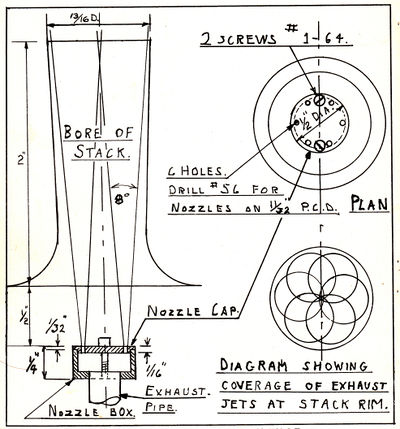A Multi-Nozzle Exhaust for Small Locos
Cateogry::Steam Locomotive Parts A Multi-Nozzle Exhaust for Small Locos
George Hill, Toronto, Ontario
The North American Live Steamer, Volume 1 Number 4
The six nozzle exhaust shown in the sketches I made for my 2-1/2 inch gauge loco last fall (1955). Have tried out several nozzle caps; one having 4 holes on a circle with one central hole was given first chance, the remainder all being the six hole type as sketched. Why a six hole nozzle? Well, now, ain't 6 holes about the easiest to lay out in a circle? Try laying out a 7, 8 or 9 hole one and you will see (refer to Bolt Circle Layout).
Of course a smaller nozzle will generally clear up a shy steamer; but in my opinion, of all the things that can be done, this is the last resort. Previous to making this multi-nozzle thing, my loco ran with a single 1/8 inch diameter nozzle and a 5/8 inch bore liner in the stack; the blower had to be left on a little to keep up the steam pressure, especially when Mr. Axle-Driven Pump commenced business. The stack line is now removed, and with the multi-nozzle doodad, the pops get busy as never before, and without the help of the blower once the loco is rolling.
The multi-nozzle exhaust is no new thing in American full size locomotive practice. Since before 1927, the Norfolk & Western Railroad have used them. Maybe I have not been listening, so I have not heard of any small loco so equipped around this part of the world. The latest locomotive test bulletin from Britsh Railways, also independent observers of locomotive performance over in England, have established the fact that a certain class of loco known as a Spam Can, is a "most effective and capable engine", and that the multi-nozzle exhaust has a "definite advantage".
While my sketches of the apparatus are for 2-1/2 inch gauge, the larger gauges will be able to enlarge the little one, or devise their own proportions to suit. Six holes seems to be the least that can be used to get decent coverage of the stack at the top. It will be noted that the jets of steam do not quite fill the stack; there is a small amount of space for the smoke to get away! I can assure all interested that the nozzle cap shown does not permit any back flow down the stack. I now test all blower and front end adjustments before going to the track by means of a lazy naked flame, such as a lighted match; just run it around the rim of the stack while steam is being worked, with the engine jacked up, actually "proved by fire". Alignment of the nozzle box is obtained in the usual way, in this case by means of a 1/8 inch rod pushed into a reamed hole in a cap about 1/8 inch thick. The nozzle box is silver soldered to the exhaust pipe. Top edge of box is only 1/32 inch wide and faced dead flat, so that caps sit down and without any fear of blows at exhaust pressure. The shallow spigot on the nozzle caps is fitted with 0.003 inch to 0.005 inch clearance in the box. No gasket is used at this joint, I hate small gaskets. The nozzle caps can be changed in a few minutes, even in 2-1/2 inch gauge, and with no fear of disturbing alignment of anything. I guess the sketches will provide enough information for any Live Steamer to go ahead and engineer a multi-nozzle exhaust for his engine, even so, I would be pleased to answer any inquiries that might arise.
Last, but not least, because the area of the six nozzles is about 43% larger than the single 3/32 inch nozzle required to steam the loco freely, she operated with so much less back-pressure on the pistons.
